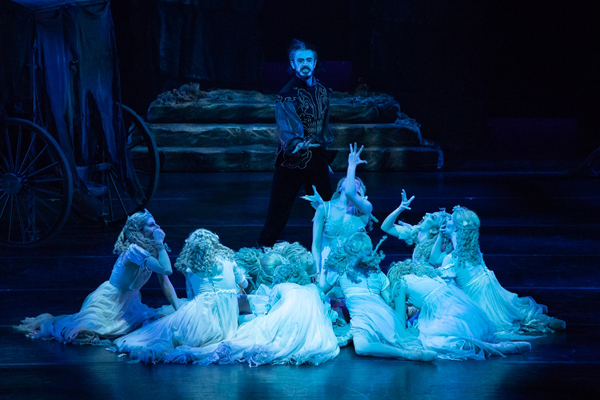NBT DELIVERS DYNAMIC DRACULA
By: Hal de Becker
Photos: Alicia Lee
Brilliantly conceived; brilliantly choreographed; brilliantly danced: That describes NBT’s opening night performance of Ben Stevenson’s Dracula ballet at The Smith Center.
This was not a fairy tale or spoofy Halloween ballet, but rather a serious dance fantasy of the macabre yet fascinating vampire legend. It was Stevenson’s own intriguing version of the Dracula story not a replication of the Bram Stoker novel.
The choreography was exceptionally imaginative, richly textured and, despite the grim plot, frequently beautiful. NBT’s dancers, rehearsed by Dominic Walsh, gave an impeccable performance.
The action ranged from Dracula’s bloodlust and ruthless enslavement of 18 victim-brides to the betrothed young village couple whose love sparks a joyous celebration with their fellow villagers.
Stevenson didn’t advance the story by resorting to banal and obvious scare tactics. Like most good story-tellers he let the ballet tell the tale, enabling it and our own imaginations to take over. Gradually, and in spite of knowing better, it sometimes seemed almost believable.
The music, drawn from works by Franz Liszt, masterfully arranged by John Lanchbery, sounded like an original score commissioned expressly for this ballet. I suspect the maestro and choreographer spent countless hours researching Liszt’s oeuvre to find such suitable compositions.
The many special effects including, of course, ‘flying’, evolved from within the context of the ballet rather than being a competitive distraction from it.
We, and particularly youngsters, were spared the sight of excessive blood and gore and the prosaic stake being driven into Dracula’s heart. Such omissions were in good taste and in no way compromised the chilling impact of the ballet.
In Act I, set in a gloomy, candle-lit crypt beneath Dracula’s castle. Steven Goforth made his entrance in the title role. Attired in black and enfolded in a huge cape concealing the wings of a bat, he made an imposing but fearful figure.
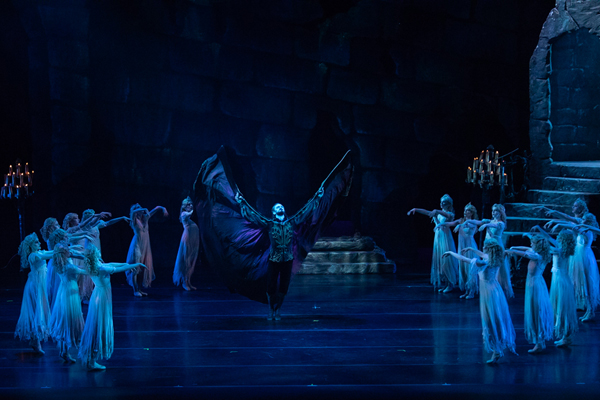
Goforth’s powerful dancing and acting captured the Count’s inherent evilness as well as his aristocratic elegance. He was so immersed in the role that he seemed to be living it as much as playing it.
In an interesting motif whenever Dracula executed pirouettes, instead of rounding his arms in front he’d hold them horizontally, palms down, across his throat. The threatening allusion was clear.
Robert Fulton acted as a double for Dracula to create the illusion that he moved with incredible speed from one place to another.
The sculpted tableaux, undulating serpentine arms and graceful, lyrical movements of the slave-brides were especially beautiful and made their hopeless plight even more pitiful.
At one point, waiting in fear for Dracula’s arrival, they darted frantically in all directions and with their white gossamer dresses swirling around them resembled a swarm of terrified moths.
After being abducted from her village by Dracula’s servant Renfield, Flora, danced by Alissa Dale, became the vampire’s latest slave and performed a dramatic duet with him.
Robert Mulvey portrayed the depraved, insect-eating servant convincingly.
Jaime DeRocker and Kathrine Zimmerman, as mesmerized slave-brides were forced to dance a trio with Dracula composed of inventive classical ballet moves, unique lifts and intertwined bodies. They were expertly partnered by Goforth and everyone stayed in character despite the challenging choreography.
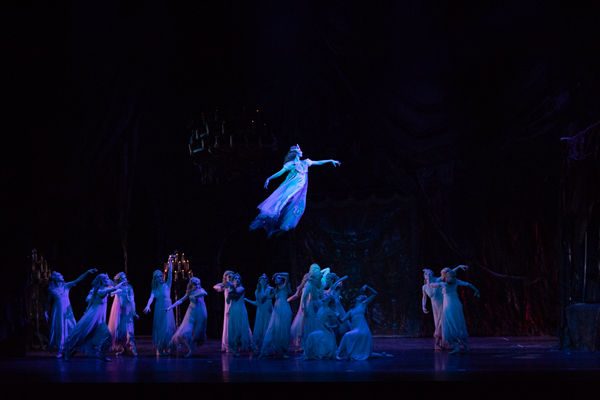
A Transylvanian village square was the setting for Act II’s festivities honoring the betrothal of the young lovers Svetlana and Frederick, danced respectively by Mirella Costa Neto and Sergio Alvarez. The handsome couple performed flawlessly in a romantic pas de deux and bravura solos.
As the Old Lady and village matriarch, Russian trained Monika Rostomian’s mimed acting was executed with artistry and exceptional clarity. Enrico Demarco’s spirited folkloric dancing and comedic flair were also impressive.
Fueled by wine and the happy occasion, the villagers’ dancing built to a rousing, show-stopping finale.
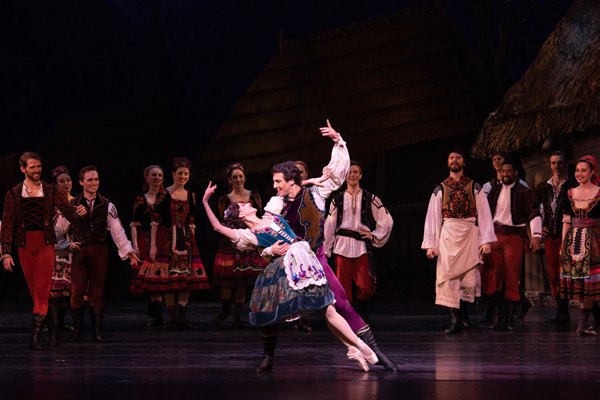
Tragically, their jubilation was short lived as Dracula burst upon the scene intent upon having Svetlana. His funereal coach was drawn by two grotesque reptilian creatures, with Flora, now a vampire, clinging to the back of it mocking Frederick and the villagers.
Act III, at the castle, was filled with action and compelling dancing. Just as Dracula was about to consummate his blood-lust with Svetlana, Frederick and the villagers rushed in determined to save her. Because of the ensuing battle Dracula’s return to the safe darkness of his sarcophagus was delayed and he was caught in a shaft of sunlight and destroyed.
Sets and costumes were breathtaking and credited respectively to Thomas Boyd and Judanna Lynn. The village square abounded with cottages and color while the castle’s grey stone walls were bleak. The difference was striking and an effective reflection of both worlds.
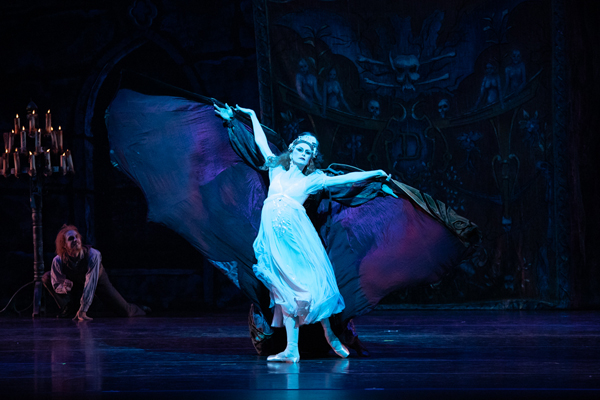
The brides’ costumes of wafting dresses added to the eerie atmosphere as did Dracula’s richly embroidered wings. The village scene was enhanced with its colorful, highly decorated costuming.
Dracula and some of his brides frequently soared high in flight above the stage. Thanks to their own skills, and coaching from Flying by Foy, they made it look like the real thing.
NBT’s Dracula production was generously sponsored by the Houssels family and was the third since Roy Kaiser became the company’s Artistic Director. The success and high caliber of these recent productions should establish NBT as a major American ballet company.
